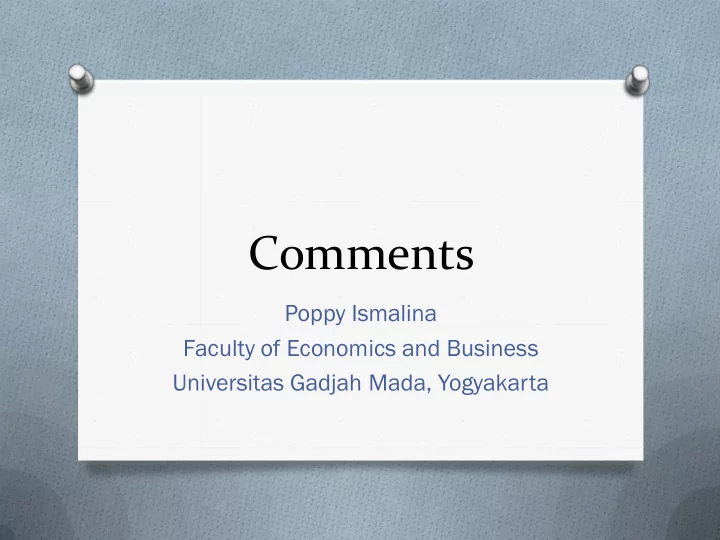

Comments Poppy Ismalina Faculty of Economics and Business Universitas Gadjah Mada, Yogyakarta
Introduction O Comments on “ Trade and Labour Market Adjustments ” by Susan Stone, Clarisse Legendre and Patricia Sourdin (OECD) O Six economies: four OECD (Canada, Israel, the United Kingdom (UK) and the United States (US) and two non OECD (Brazil and South Africa) O 2003 - 2008
The existing research O Focus on Brazil and South Africa O All of them uses a partial equilibrium model with traditional industry measures O Trade reforms, efficiency and growth (Hay, 2001) O Trade liberalization and the growing wage inequality (Muendler, 2002)
The existing research O Returns to educated workers and trade liberalization (Blom, Holm-Nielsen and Verner, 2001), Green, Arbache and Dickerson (2001), Behrman, Birdsall, Szekely (2000) O Trade liberalization and wage inequality between skilled and unskilled workers (Pavcnik, et.al. 2002)
OECD Paper: Insightful Contributions O A partial equilibrium approach O A harmonized cross-sectional, time series dataset at a more detailed occupation- based level: O Examine the impact across different types of labour O Observe a detrimental impact on medium skilled workers vis a vis other skill levels, from all trade variables
Insightful Contributions O Go beyond traditional industry measures O Identify the real drivers of labour market adjustment to increasing economic ties among countries:
The substantial problems O The labour market adjustment can be seen as a combination of private and social cost. O In developed countries like Canada, US, UK, social costs occurred from the labour market adjustment is not as high as in developing countries like Brazil and South Africa. O Developing countries have different problems in terms of the impact of trade reforms on labour market adjustments
The substantial problems O Susan ’ s paper examines social cost in a qualitative sense. O One model for six economies (four OECD countries, two non OECD (Brazil and South Africa) O A partial equilibrium model can ’ t bring us to solve those mentioned substantial problems
The Brazilian Economy O a major agricultural exporter O a country with one of the world's most unequal income distributions O e.g. large-scale commercial farmers vs country ’ s small holders
South Africa ’ s Economy O has experienced elevated growth in an environment of rapid credit expansion, booming asset prices, strengthening public finances, and rising international reserves financed by large capital inflows. O unemployment is one of the biggest challenges to economic growth in the country.
Duality Economy (Formal and Informal) O South Africa's economy has a marked duality, with a sophisticated financial and industrial economy having grown alongside an underdeveloped informal economy. O While SA's financial and industrial "first economy" has an established infrastructure and economic base, its informal "second economy" presents both untapped potential and a developmental challenge for the country.
Proposed Ideas O Provide more additional insights for developing a policy framework. O Analyze the impact of trade changes on employment of the entire economy O Consider more a connection among output, labour (and therefore productivity), household, income, expenditure O Use open economy approach
Proposed Ideas O In addition, the acceptance of quantitative models is most likely higher when the technique is fairly simple and more related to real data O Policy advisors have made the experience that complicated models may not be used if the are not well understood by the targetted users.
Proposed Methods O A combination of a National Accounting Matrix (NAM), a dynamic labour-oriented Social Accounting Matrix(SAM) and a labour account. O The expansions of a NAM into sub-matrices focusing on the role of people in the economy - the transition to a dynamic ic labour ur-orient oriented ed SAM.
Proposed Methods O The area covered by SAMs is the link between two often distinct worlds of statistics: economic statistics and social statistics. O Linking labour market and income distribution issues to macro-economic policy objectives. O Exports and imports are considered endogenous factors.
Proposed Methods O SAMs can be even more valuable if they are combined with detailed labour accounts. Labour income and employment can be disaggregated by industry and type of labour, and also by type of labour and household group. O SAMs and the labour accounts are linked by a set of tables that expand national accounts estimates of monetary and non-monetary labour market variables. SAMs and labour accounts partly overlap.
Proposed methods O Combining NAMs, SAMs and labour accounts may be useful to transform liberalizing countries like Brazil and South African into “ the competitive and dynamic economy in the world capable of sustainable economic growth with more and better jobs and greater social cohesion environment.
Thank you
Recommend
More recommend